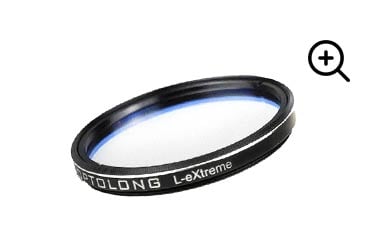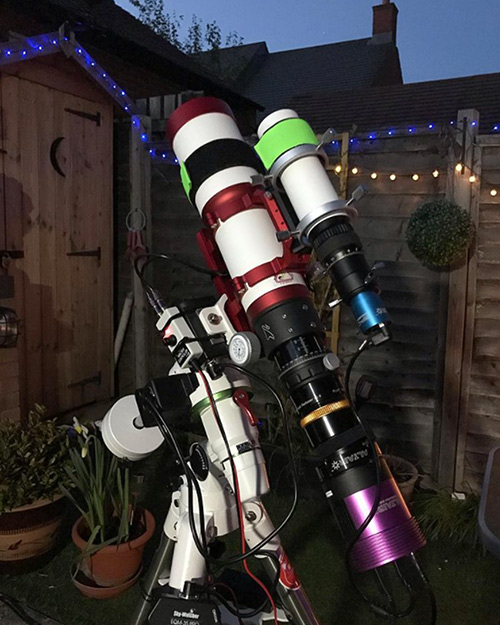Backyard of the Week | October 25, 2021
The AstroBackyard Backyard of the Week highlights astrophotography setups from around the world. A “backyard” can be a balcony, driveway, garden, or wherever else you set up astrophotography equipment at home.
By taking a behind-the-scenes look at the equipment amateur astrophotographers use to take deep-sky images, you can get a better understanding of the process.
This week’s backyard astrophotography equipment profile comes to us from Jim Owen in the United Kingdom.
Location: East Mids, United Kingdom
Jim Owen
Jim has captured many incredible images of space from his back garden in the UK. He uses a wide-field apochromatic refractor telescope and a dedicated astronomy camera to photograph galaxies and nebulae in the night sky from home.
His astrophotography setup is compact and portable, meaning Jim can get out more often. His equatorial telescope mount (including the tripod) weighs just 22-pounds, making it a practical choice for a last-minute astrophotography session.
His primary imaging camera is an Altair 294C Pro-Tec, which utilizes a popular one-shot-color CMOS sensor in the astrophotography community. I have heard nothing but great things about this camera, and Jim’s photos confirm that it is indeed a consistent performer.
The Western Veil Nebula by Jim Owen
A quality APO wide-field refractor telescope and a capable one-shot-color camera can produce outstanding images, even from a light-polluted backyard. The key is choosing the right filter for the object and imaging conditions, and Jim has got this part down pat.
Here is a complete breakdown of Jim’s deep-sky astrophotography kit:
Jim’s Equipment
| Primary Camera | Altair 294C Pro-TEC |
| Primary Telescope | William Optics Gran Turismo 81 |
| Mount | Sky-Watcher EQM-35 Mount |
| Filters | Optolong L-Pro + L-eXtreme |
| Guide Scope | Altair 50mm Starwave |
| Guide Camera | Altair GP Mono |
The Iris Nebula by Jim Owen
What does Jim love most about his gear?
“What I love most about my set up is how easy I’ve made it to set up, being lightweight I’m able to be set up and imaging within 10 mins. The EQM 35 is very underrated but I’ve managed 12 min exposures with no trailing issues at all.”
The Camera
Jim uses an Altair 294c Pro-Tec color camera to photograph deep-sky objects through his telescope. This camera uses the same Sony CMOS sensor found in the ZWO ASI294MC Pro, which I used extensively for several years.
This camera has a pixel size of 4.63 microns, making it a great choice for telescopes with a focal length of about 500mm or more. Clearly, it’s an excellent match for Jim’s William Optics GT81 with a focal length of just under 500mm.
Altair 294 Pro-Tec
The Filters
The Optolong L-Pro and L-eXtreme filters make regular appearances on the AstroBackyard Backyard of the Week. Between the two of them, Jim is able to bounce back and forth between broadband true-color, and dual bandpass narrowband imaging.
The Optolong L-Pro excels at capturing natural-color images while reducing the negative effects of light pollution. This is a great option when shooting a target on a night without moonlight when you want to collect natural star colors (especially in the blue spectrum).
Optolong L-Pro
The L-Extreme filter is best utilized when capturing nebulae subjects that emit a strong signal in the H-Alpha and OIII bandpasses. The OIII signal recorded will be much dimmer than Hydrogen, but capturing both bandpasses with a color camera is a great way to maximize your exposure time under a clear sky.
This filter can be used when the moon is out and can produce surprisingly quality data from the city. Certain subjects (such as planetary nebulae and supernova remnants) seem to jump off the screen when captured with this filter.
Optolong L-eXtreme
I noticed that Jim uses a filter slider drawer to quickly swap between his 48mm round mounted filters. As long as you have the right spacing between the camera sensor and your telescope (and/or focal corrector), a filter drawer is the most convenient way to mount a 2″ light pollution filter to your setup.
Jim’s backyard deep-sky imaging rig.
The Telescope
The William Optics Gran Turismo 81 is a 3-element (triplet) apochromatic refractor telescope with a focal length of 478mm at F/5.9. This telescope includes a few added features that amateur astrophotographers can appreciate including a built-in focus mask, and a camera angle rotator.
This model also includes a handy mounting bar on top of the optical tube to mount a small guide scope and guide camera for autoguiding. The William Optics refractors are always a safe bet. I’ve owned many William Optics telescopes over the years, and they consistently meet and exceed my expectations as a backyard astro-imager.
William Optics GT81 Triplet APO refractor.
Jim’s telescope mount is well suited for a refractor of this size (8.4 pounds). His computerized telescope mount can easily handle the weight of this OTA, along with all of his additional photography gear from the guide scope to his primary imaging camera.
William Optics GT81 APO
- Type: Apochromatic Refractor
- Diameter: 81 mm
- Focal Length: 478 mm
- Focal Ratio: f/5.9
- Field Flattener: 6AIII 0.8X
- Weight: 8.4 lbs (3.84 kg)
The Telescope Mount
The Sky-Watcher EQM-35 Pro is an affordable computerized GoTo telescope mount with a maximum payload capacity of 22 pounds. The EQM-35 is an astrophotography-worthy mount that keeps overall weight to a minimum.
It includes the Sky-Watcher SynScan hand controller with a 42,000+ object database for you to explore. The Vixen-style mounting plate on the mount head allows you to mount a compact refractor telescope and all of your astrophotography accessories.
Sky-Watcher EQM35 Pro
It will be tough to find a comparable imaging platform with a better price than the EQM-35. This mount sits directly between a star tracker such as the Sky-Watcher Star Adventurer, and a larger equatorial mount like the Sky-Watcher HEQ5 Pro.
The Guide Scope
Jim uses an Altair 50mm Starwave guide scope to provide his guide camera a suitable field of view for autoguiding. The Starwave guide scope is sold as a package from Altair Astro.
The Altair Starwave 50mm guide scope package.
The Guide Camera
The Altair GPCAM mono is a suitable guide camera for astrophotography when used with the right guide scope. The camera comes with a built-in ST4 autoguiding port and a USB connection for your PC.
Jim uses the PHD2 Guiding autoguiding software to improve the tracking accuracy of his Sky-Watcher EQM-35 equatorial mount.
Altair GPCAM Mono
Thank you for sharing your backyard astrophotography set up with us, Jim! You can view his astrophotography on Instagram.
Be sure to fill out the form to submit your backyard for a chance to be featured, and don’t forget to include your Instagram handle to help grow your following.
Soul Nebula by Jim Owen
View the Backyard of the Week Archives











